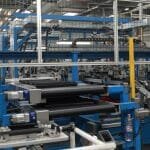~ Considerations for choosing the right conveyor belt type and material in food processing applications ~
The complexities of dealing with food safety and hygiene make choosing the right conveyor belt for food processing applications a crucial task. Here Anna Marcol, marketing communications manager at conveyor and power transmission belt specialist Habasit, explores the findings of a recent webinar that discussed how hygiene-rated equipment and the right choice of belt type and material are crucial in achieving food safety.
While food plant managers do a good job of keeping their facilities clean, food debris and microbes can still find their way into the smallest of dead spots. Bacteria can harbour on and in conveyor frames, under equipment, under the belt, or even in the small gaps of a modular belts. What’s more, they can survive even the most rigorous cleaning cycles, leading to excessive use of detergent, water, time, and energy.
When thinking about food safety and hygiene, food processing operators should consider two key areas. They must think about hygiene-rated equipment and selecting the right food-contact elements, including belt type and material.
Hygienic approach
In open conveyor systems, food debris can contaminate surfaces and get into crevices and internal support structures over time. While effective cleaning and sanitation plans reduce contamination, equipment and components designed specifically for hygiene can take less time, water and cleaning agents to clean and sanitise.
Therefore, equipment and components should be appropriately hygiene certified for food. This includes meeting minimum hygiene standards in accordance with industry guidelines such as 3-A, NSF or EHEDG, as well as being compliant with the food contact regulations by the FDA or EU 1935/2004, and other national regulations.
Hygiene certified components consider, among other factors, the cleanability of surfaces, preventing ingress and the growth of microbes in dead spaces, self-draining surfaces or on levelling-feet or castors and much more. However, these measures are only a means to an end. We wanted to share our experiences and participate in the dialogue on food safety, so Habasit’s Hygiene Program Manager, Bernd Roser recently delivered a webinar on food safety jointly with Niels Vindsmark, Sales and Brand Owner Program Manager at hygienic component manufacturer NGI.
In the webinar Niels explained, “Applying hygienic certified components will not avoid an outbreak, but the more problems you can eliminate and the more certified hygienic components you have in your production facility, the less places you have to look at and worry about if you have an outbreak.”
Belting
Bernd Roser pointed out that food plant managers should consider three areas when using open conveyor systems: choosing the right conveyor design, choosing the right food contact material to match the process conditions and selecting belts that support ease of cleaning.
A conveyor design supporting sanitary needs is one that provides easy access to belting from all sides, allowing operators to inspect, clean, sanitise and validate effectively. When selecting the right food contact material, it’s important food processors choose a belt that doesn’t change its mechanical properties or wear quickly when regularly exposed to harsh, chemical-based cleaning cycles, at elevated temperatures and with extended contact times.
To support engineers in identifying the chemical resistance of various belt types and materials, Habasit created a free online tool to help users decide the best belt for them. For applications exposed to very demanding hygiene conditions, Habasit developed Super HyCLEAN, a plastic modular belt that minimises the use of rods and hinges to aid cleaning, ideal for applications such as fish and poultry.
Whatever the food processing application, choosing the right conveyor belt, and ensuring equipment is designed with hygiene in mind is pivotal. This will help food processors comply with industry standards and ensure the industry can continue to reduce the dangers of contamination while making it easier for plant managers to run their facility.
To find out more about choosing the right conveyor belt and to watch Habasit’s recent webinar on demand for free, visit https://bit.ly/FoodConveyorWebinar





